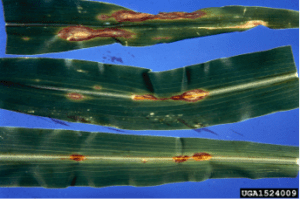Nathan Kleczewski, Extension Specialist – Plant Pathology; nkleczew@udel.edu
The recent warm, rainy weather has been favorable for some foliar pathogens in corn, in particular, anthracnose. Foliar symptoms of anthracnose are often observed in young corn (prior to V5 in many cases). Lesions tend to be irregular, reddish-brown, and have a “target-like” appearance. If you are lucky and have a hand lens you may observe tiny black structures in the lesions with black hairs. The foliar symptoms in the lower canopy can stop in some hybrids after the V6 stage. In other hybrids, a resurgence in foliar symptoms and top dieback in the upper canopy may occur after tasseling if the environment is conducive for disease.
Figure 1. Foliar symptoms of Anthracnose of corn. Image obtained from www.bugwood.org.
Anthracnose overwinters in residue. It does well not only in corn residue, but also that of small grains and other grassy plant species. Spores are splashed onto the lower leaves where they infect and cause lesions. Under continued wet and warm weather the lesions will produce spores which result in additional lesions and disease. It is important to note that Anthracnose stalk rot is caused by infection of the roots but may be facilitated by mechanical damage such as hail or insect injury.
In terms of within-season management, early fungicide applications at V5 will not be helpful in situations where the disease is present prior to this point. The stalk rot phase, which is the most damaging to the crop, is mostly caused by root infections and therefore is not likely to be impacted by fungicides. Early fungicide applications (V5/6) made prior to the onset of disease can reduce further development of Anthracnose on foliage in the lower canopy but will not likely have an impact on any disease that may develop later in the season in the upper canopy. University research trials (of various sizes) have not shown any significant yield increase when programs incorporating a V5/6 fungicide application and a VT-R1 application are compared to programs utilizing a single fungicide application at VT-R1.
If you have fields with a history of anthracnose the best management practices include integrating 1) hybrids with good resistance to anthracnose, 2) crop rotation, 3) insect management and stress mitigation, and where possible, 4) tillage to bury residue. Resistance to the foliar phase of the disease does not necessarily mean it is highly resistant to the stalk rot phase. When looking at varieties make sure to check with the seed dealer to determine how resistance was determined for a particular hybrid. Rotation away from corn for at least one year can significantly reduce early season foliar symptoms of the disease, but may not have much of an impact on top dieback or stalk rot phases of the disease.
A new factsheet with additional information on this disease and its management can be found here: http://extension.udel.edu/factsheet/anthracnose-leaf-blight-and-stalk-rot-of-corn/.
ALSO
Check out the recent post to the Field Crops Disease Management Blog titled “Getting Bins Ready for Wheat Storage” at: http://extension.udel.edu/fieldcropdisease/2014/06/20/getting-your-bins-ready-for-wheat-storage/

